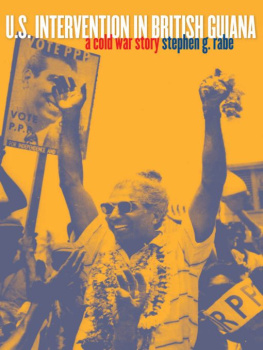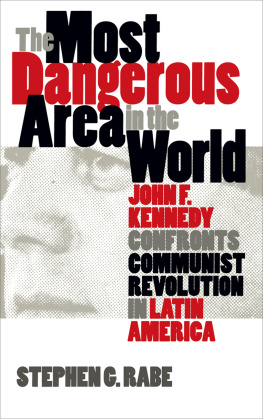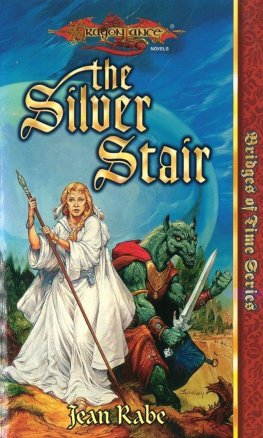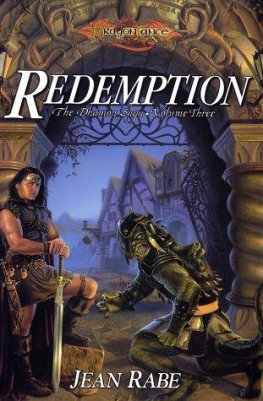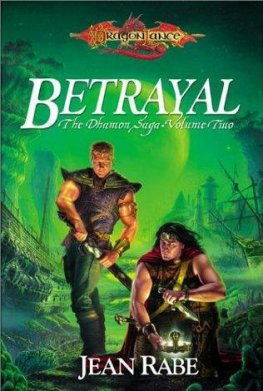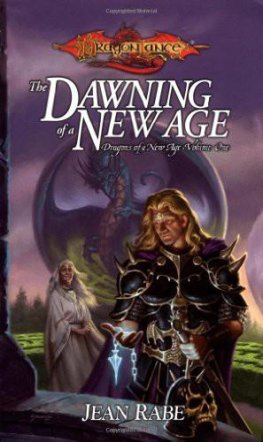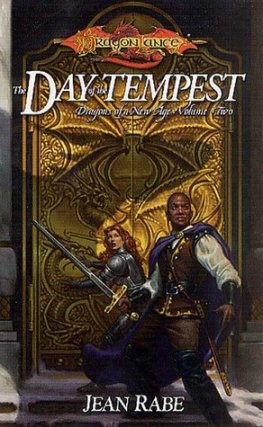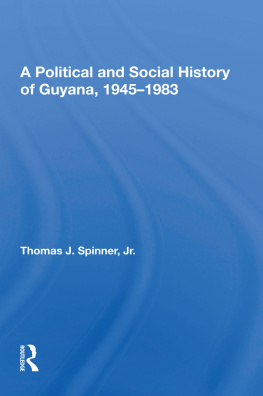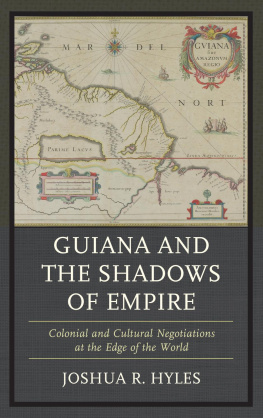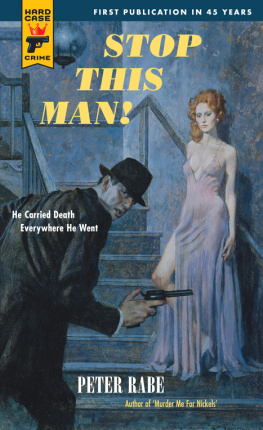
2005 The University of North Carolina Press
All rights reserved
Manufactured in the United States of America
Designed by Kimberly Bryant
Set in Filosofia by Keystone Typesetting, Inc.
Frontispiece: Cheddi Jagan in Georgetown on 23 August 1961 following his partys victory in British Guianas general elections. (AP/Wide World Photos)
The paper in this book meets the guidelines for permanence and durability of the Committee on Production Guidelines for Book Longevity of the Council on Library Resources.
Library of Congress Cataloging-in-Publication Data Rabe, Stephen G.
U.S. intervention in British Guiana : a Cold War story / Stephen G. Rabe.
p. cm.(The new Cold War history)
Includes bibliographical references and index.
ISBN 0-8078-2979-X (cloth : alk. paper)
eISBN : 97-8-080-78769-6
ISBN 0-8078-5639-8 (pbk. : alk. paper)
1. GuyanaPolitics and government1803-1966.
2. GuyanaPolitics and government1966- .
3. Subversive activitiesGuyanaHistory20th century. 4. United States. Central Intelligence
AgencyHistory20th century. 5. GuyanaRelationsUnited States. 6. United StatesRelationsGuyana. 7. Cold War. I. Title. II. Series.
F2384.R33 2005
988.103dc22 2005008004
cloth 09 08 07 06 05 5 4 3 2 1
paper 09 08 07 06 05 5 4 3 2 1
FOR THE PEOPLE OF GUYANA,
who have endured slavery, servitude,
colonialism, and imperialism
MAP & ILLUSTRATIONS
MAP
British Guiana in the 1950s 2
ILLUSTRATIONS
Cheddi Jagan and Janet Rosenberg Jagan in the United States in 1943 26
Prime Minister Cheddi Jagan and President John F. Kennedy at the White House, 25 October 1961 88
Prime Minister Forbes Burnham and President Lyndon Johnson outside the White House, 21 July 1966 156
Cheddi Jagan and Janet Jagan in Guyana a few days after the 1992 presidential election victory 171
ACKNOWLEDGEMENTS
In investigating and writing this book, I incurred many scholarly debts. I thank the archivists at the U.S. National Archives, the U.K. National Archives, and the Eisenhower, Kennedy, and Johnson presidential libraries for their assistance. I am also grateful for the help I received from staffs who guided me through manuscript collections at the George Meany Memorial Labor Archives, the Kheel Center at Cornell University, and the Thomas J. Dodd Research Center at the University of Connecticut.
I am especially grateful to Nadira Jagan-Brancier for providing me with photographs for this book. Suzanne Wasserman of City College of New York kindly offered me several excellent insights about the political milieu of British Guiana/Guyana. Professor John Lewis Gaddis of Yale University and an anonymous referee read the manuscript twice and gave me innumerable constructive criticisms and suggestions.
This study represents my third book with the University of North Carolina Press. I salute editor Charles Grench and Amanda McMillan for supporting this project. I also thank Paula Wald for managing the production process.
I was able to devote a full year to writing with a Special Faculty Development Grant from the University of Texas at Dallas. I thank Dean Dennis Kratz of the School of Arts and Humanities and especially Provost B. Hobson Wildenthal for supporting my research and writing.
Stephen G. Rabe
Dallas, Texas
19 February 2005
ABBREVIATIONS
| AFL-CIO | American Federation of Labor and Congress of Industrial Organizations |
| CIA | Central Intelligence Agency |
| FBI | Federal Bureau of Investigation |
| NSC | National Security Council |
| ORIT | Inter-American Regional Organization |
| PNC | Peoples National Congress |
| PPP | Peoples Progressive Party |
| TUC | Trade Union Council |
| UF | United Front |
British Guiana in the 1950s
introduction
Guyana is a unique but troubled land. Officially known as the Co-Operative Republic of Guyana, the nation is situated on the northeastern coast of the South American continent, bordered on the west by Venezuela, by Surinam to the east, and by Brazil to the south. It is one of the smallest nations on the continent, about the size of the U.S. state of Idaho. Guyana is the only English-speaking nation in South America. It is also the only nation in the Western Hemisphere where the majority of the population is South Asian in origin, principally from India.
At the beginning of the twenty-first century, political, socioeconomic, and epidemiological problems bedevil the people of Guyana. With a per capita income of $824, it is one of the poorest nations in the Western Hemisphere, ranking just below Paraguay and somewhat above Haiti. Guyana is significantly poorer than Trinidad and Tobago, the other Western Hemisphere nation with a sizeable South Asian population. Guyanas infant mortality rate of 49 per 1,000 live births is about 700 percent higher than in the United States. With an average life expectancy of about 62 years, Guyanese can expect to enjoy 15 years less of life than do U.S. citizens. Guyana can boast of a literate population, with 97 percent of adults having attended school. But the nation is struggling to maintain its educational standards because of its deep poverty. Along with Haiti, Guyana is the Western Hemisphere nation that suffers most from the contemporary plague of AIDS. Over 3 percent of Guyanas adult population is infected with HIV / AIDS.
In the past four decades, the populations of Western Hemisphere nations have boomed, with big countries like Brazil and Mexico and small ones like Costa Rica more than doubling their populations. The United States has added over 80 million people to its population since 1960. Guyanas population has barely grown from 560,000 in 1960 to about 700,000 in 2000. In the recent past, Guyanas population has actually declined because of high mortality rates and emigration. In both 1998 and 1999, Guyana lost more than 1 percent of its population through emigration. Many Guyanese now reside in the cosmopolitan city of Toronto.
Under the happiest of circumstances, Guyana would struggle to achieve high rates of economic growth. Less than 4 percent of its territory, a narrow belt of land on the coastal plain, is arable. For a depth of five to eight miles, the coastal plain is below sea level at high tides. Guyanese have been forced to construct seawalls, canals, and dikes in a constant struggle to keep the land dry. Sugar and rice have been the traditional cash crops of Guyana. Neither crop has commanded a strong price on global markets in the past few decades. Guyana does mine a valuable natural resource, bauxite, from which aluminum is extracted. Unlike neighboring Venezuela or Trinidad and Tobago, Guyana does not, however, produce petroleum. Guyana also offers no haven for tourists. Its beaches are a muddy mess, when the tides recede. With its dense rain forests, Guyana could perhaps appeal to ecotourists.

